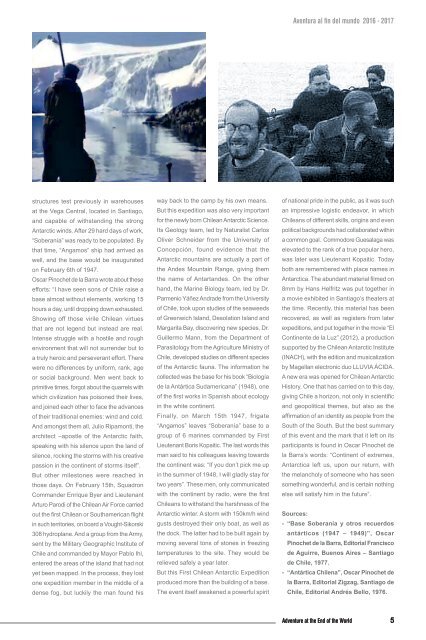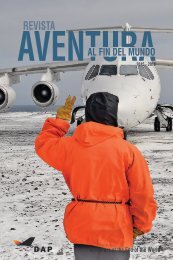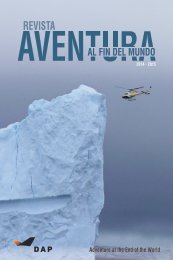DAP AVENTURA 2016 - 2017
Los invitamos a conocer nuestra mirada, a través de esta nueva edición digital de revista "AVENTURA: Al Fin del Mundo", temporada 2015-2016. Cuéntanos qué te parece en facebook.com/grupodap _______/________ We invite you to know our world, in this new digital edition of "ADVENTURE: At the End of the World" 2015-2016 season. Tell us what you think on facebook.com/grupodap Enjoy!
Los invitamos a conocer nuestra mirada, a través de esta nueva edición digital de revista "AVENTURA: Al Fin del Mundo", temporada 2015-2016.
Cuéntanos qué te parece en facebook.com/grupodap _______/________
We invite you to know our world, in this new digital edition of "ADVENTURE: At the End of the World" 2015-2016 season.
Tell us what you think on facebook.com/grupodap
Enjoy!
Create successful ePaper yourself
Turn your PDF publications into a flip-book with our unique Google optimized e-Paper software.
Aventura al fin del mundo <strong>2016</strong> - <strong>2017</strong><br />
structures test previously in warehouses<br />
at the Vega Central, located in Santiago,<br />
and capable of withstanding the strong<br />
Antarctic winds. After 29 hard days of work,<br />
“Soberanía” was ready to be populated. By<br />
that time, “Angamos” ship had arrived as<br />
well, and the base would be inaugurated<br />
on February 6th of 1947.<br />
Oscar Pinochet de la Barra wrote about these<br />
efforts: “I have seen sons of Chile raise a<br />
base almost without elements, working 15<br />
hours a day, until dropping down exhausted.<br />
Showing off those virile Chilean virtues<br />
that are not legend but instead are real.<br />
Intense struggle with a hostile and rough<br />
environment that will not surrender but to<br />
a truly heroic and perseverant effort. There<br />
were no differences by uniform, rank, age<br />
or social background. Men went back to<br />
primitive times, forgot about the quarrels with<br />
which civilization has poisoned their lives,<br />
and joined each other to face the advances<br />
of their traditional enemies: wind and cold.<br />
And amongst them all, Julio Ripamonti, the<br />
architect –apostle of the Antarctic faith,<br />
speaking with his silence upon the land of<br />
silence, rocking the storms with his creative<br />
passion in the continent of storms itself”.<br />
But other milestones were reached in<br />
those days. On February 15th, Squadron<br />
Commander Enrique Byer and Lieutenant<br />
Arturo Parodi of the Chilean Air Force carried<br />
out the first Chilean or Southamerican flight<br />
in such territories, on board a Vought-Sikorski<br />
308 hydroplane. And a group from the Army,<br />
sent by the Military Geographic Institute of<br />
Chile and commanded by Mayor Pablo Ihl,<br />
entered the areas of the island that had not<br />
yet been mapped. In the process, they lost<br />
one expedition member in the middle of a<br />
dense fog, but luckily the man found his<br />
way back to the camp by his own means.<br />
But this expedition was also very important<br />
for the newly born Chilean Antarctic Science.<br />
Its Geology team, led by Naturalist Carlos<br />
Oliver Schneider from the University of<br />
Concepción, found evidence that the<br />
Antarctic mountains are actually a part of<br />
the Andes Mountain Range, giving them<br />
the name of Antartandes. On the other<br />
hand, the Marine Biology team, led by Dr.<br />
Parmenio Yáñez Andrade from the University<br />
of Chile, took upon studies of the seaweeds<br />
of Greenwich Island, Desolation Island and<br />
Margarita Bay, discovering new species. Dr.<br />
Guillermo Mann, from the Department of<br />
Parasitology from the Agriculture Ministry of<br />
Chile, developed studies on different species<br />
of the Antarctic fauna. The information he<br />
collected was the base for his book “Biología<br />
de la Antártica Sudamericana” (1948), one<br />
of the first works in Spanish about ecology<br />
in the white continent.<br />
Finally, on March 15th 1947, frigate<br />
“Angamos” leaves “Soberanía” base to a<br />
group of 6 marines commanded by First<br />
Lieutenant Boris Kopaitic. The last words this<br />
man said to his colleagues leaving towards<br />
the continent was: “If you don’t pick me up<br />
in the summer of 1948, I will gladly stay for<br />
two years”. These men, only communicated<br />
with the continent by radio, were the first<br />
Chileans to withstand the harshness of the<br />
Antarctic winter. A storm with 150km/h wind<br />
gusts destroyed their only boat, as well as<br />
the dock. The latter had to be built again by<br />
moving several tons of stones in freezing<br />
temperatures to the site. They would be<br />
relieved safely a year later.<br />
But this First Chilean Antarctic Expedition<br />
produced more than the building of a base.<br />
The event itself awakened a powerful spirit<br />
of national pride in the public, as it was such<br />
an impressive logistic endeavor, in which<br />
Chileans of different skills, origins and even<br />
political backgrounds had collaborated within<br />
a common goal. Commodore Guesalaga was<br />
elevated to the rank of a true popular hero,<br />
was later was Lieutenant Kopaitic. Today<br />
both are remembered with place names in<br />
Antarctica. The abundant material filmed on<br />
8mm by Hans Helfritz was put together in<br />
a movie exhibited in Santiago’s theaters at<br />
the time. Recently, this material has been<br />
recovered, as well as registers from later<br />
expeditions, and put together in the movie “El<br />
Continente de la Luz” (2012), a production<br />
supported by the Chilean Antarctic Institute<br />
(INACH), with the edition and musicalization<br />
by Magellan electronic duo LLUVIA ÁCIDA.<br />
A new era was opened for Chilean Antarctic<br />
History. One that has carried on to this day,<br />
giving Chile a horizon, not only in scientific<br />
and geopolitical themes, but also as the<br />
affirmation of an identity as people from the<br />
South of the South. But the best summary<br />
of this event and the mark that it left on its<br />
participants is found in Oscar Pinochet de<br />
la Barra’s words: “Continent of extremes,<br />
Antarctica left us, upon our return, with<br />
the melancholy of someone who has seen<br />
something wonderful, and is certain nothing<br />
else will satisfy him in the future”.<br />
Sources:<br />
- “Base Soberanía y otros recuerdos<br />
antárticos (1947 – 1949)”, Oscar<br />
Pinochet de la Barra, Editorial Francisco<br />
de Aguirre, Buenos Aires – Santiago<br />
de Chile, 1977.<br />
- “Antártica Chilena”, Oscar Pinochet de<br />
la Barra, Editorial Zigzag, Santiago de<br />
Chile, Editorial Andrés Bello, 1976.<br />
Adventure at the End of the World<br />
5




